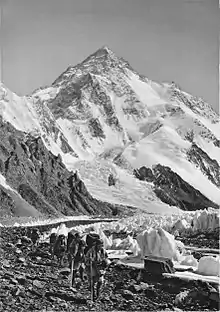adret
English
WOTD – 31 July 2018
Etymology

A 1909 photograph by Vittorio Sella of the adret of K2, the second-highest mountain in the world, viewed from the Godwin-Austen Glacier.[n 1]
Borrowed from French adret or Occitan adret, adré, adrech, adreit (“sun-facing side of a mountain”), from Old Occitan adreg, adreit, from a (“to, towards”) (from Latin ad (“to, towards”), ultimately from Proto-Indo-European *h₂éd (“at; to”)) + dreg, dreit (“just; right”) (from Latin dīrectus (“direct, straight”), ultimately from Proto-Indo-European *h₃reǵ- (“to straighten, right oneself; just, right”)); compare French adroit.[1]
Pronunciation
- (Received Pronunciation) IPA(key): /ˈædɹeɪ/
- (General American) enPR: ə-drāʹ IPA(key): /əˈdɹeɪ/
- Rhymes: -eɪ (GA)
Noun
adret (plural adrets)
- (geography) The sun-facing side of a mountain.
- Antonym: ubac
- 1942, Japanese Journal of Geology and Geography: Transactions, Titles and Abstracts, Tokyo: Nihon Gakujutsu Kaigi [Science Council of Japan], ISSN 0021-5058, OCLC 748645064, page 34:
- The distribution of barley is generally on the adret slope, the ubac seeming to be disregarded. A sunny slope is the most important natural factor in the cultivation of barley and wheat. Very rarely they are cultivated in ubac fields, but close investigation showed them to be of secondary adret nature. In this case seeds are sown a month earlier and mown ten days later than on the adret slope.
- 1987, John J. Baxevanis, “The Wines of Savoie”, in The Wines of Champagne, Burgundy, Eastern and Southern France, Totowa, N.J.: Rowman & Littlefield, →ISBN, pages 70–71:
- Viticulure in an alpine (Savoie) or sub-alpine environment (like the Jura) is a precarious activity […] Exposure, by contrast, exaggerates or modifies the quantity of the altitudinal elements in terms of ubac (shady) versus adret (sunny) positions, wet and dry positions, or windy and protected positions, respectively. The advantages of adret slopes, which are usually drier and more protected, are evident and of paramount importance. Adret aspects receive much higher levels of direct sunlight, which produces higher soil and plant temperatures.
- 1998, Harry Blijenberg, Rolling Stones?: Triggering and Frequency of Hillslope Debris Flows in the Bachelard Valley, Southern French Alps (Nederlandse Geografische Studies; 246), Utrecht: Koninklijk Nederlands Aardrijkskundig Genootschap/Faculteit Ruimtelijke Wetenschappen Universiteit Utrecht, →ISBN, page 72:
- The vegetation of the Bachelard Valley mainly consists of forests and alpine pastures. Above the tree limit, alpine pastures and bare rock outcrops dominate the landscape. The location of the tree limit depends on factors like slope aspect and lithology. On south-facing slopes (adrets) the tree limit can reach as high as 2400 m, but on the shadowy north-facing slopes it is usually near 2200 m.
Related terms
Translations
Notes
References
- “adret, n.”, in OED Online


French
Etymology
Borrowed from Occitan.
Pronunciation
- IPA(key): /a.dʁɛ/
Antonyms
Further reading
- “adret” in le Trésor de la langue française informatisé (The Digitized Treasury of the French Language).
This article is issued from Wiktionary. The text is licensed under Creative Commons - Attribution - Sharealike. Additional terms may apply for the media files.